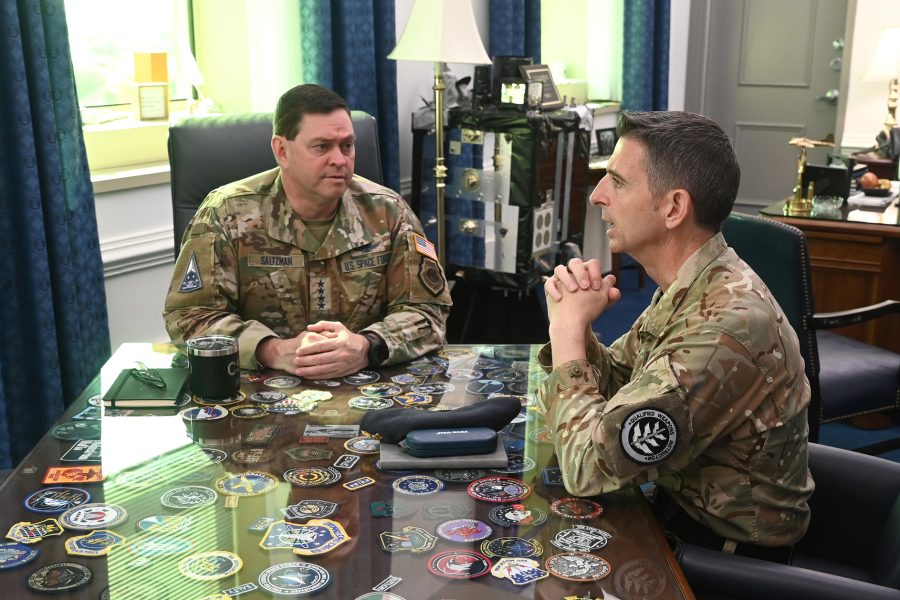RESTON, Va.—The Space Force may have stopped work on its Futures Command, but the service is still crafting future plans, to include a strategy for how it will work with international partners, a top official said.
RAF Air Marshal Paul Godfrey, currently serving in an exchange role as Assistant Chief of Space Operations for Future Concepts and Partnerships, teased some high-level details of the forthcoming strategy at the National Security Space Association’s Defense and Intelligence Space Conference.
At prior conferences, Godfrey has spoken of his role in helping establish Space Futures Command, a new field command that was one of the Space Force’s signature efforts from the Department of the Air Force’s “re-optimization for Great Power Competition.” Progress on that reorganization has been paused while the department waits for new civilian leaders as part of President Donald Trump’s administration.
On Feb. 11, Godfrey noted that his portfolio includes work “shaping futures,” but he was quick to note that “when I talk about shaping futures, I am not talking about standing up Futures Command.”
Rather, Godfrey said his focus is on “driving the Space Force to think about allied, commercial, and partner in every capability, every operation, and every mission.”
Space Futures Command was set to have a major role in that by studying new technologies and conducting wargaming and analysis—with allies and partners—to decide what capabilities the Space Force will need in years ahead.
Even without the command for the time being, Godfrey outlined several ways the Space Force is trying to work more closely with international partners, chief among them a new International Partnerships Strategy set to be released “in the coming months.”
While declining to discuss specifics, Godfrey said the strategy will focus on integration “across the three elements of joint force development”:
- Force design, including work on long-term needs within the next five to 15 years
- Force development, including work to acquire and integrate new technologies within two to seven years
- Force employment, which includes generating and operating combat power within three years or less.
In keeping with Chief of Space Operations Gen. B. Chance Saltzman’s idea that the Space Force must be prepared for continual “competitive endurance,” Godfrey said the strategy “won’t have a static end state, but will rather use three enduring goals”:
- Secure U.S. and allies’ collective interests in, from, and to space
- Interoperability and information sharing across classification levels
- Integration of allies and partners across every aspect of joint force development
To get there, Godfrey added, the strategy “sets the conditions” for allies to be included in Space Force planning, to develop information standards, to increase information sharing, and to increase opportunities for countries to train and operate together.
To achieve these goals, the strategy sets the conditions for allies and partners to be integrated into the Space Force’s planning and capability development, helps develop international standards, improves information sharing, and maximizes opportunities for allies and partners to train and conduct operations together.
Pentagon leaders have said collaborating with other countries, as well as industry, is especially important for the Space Force given the service’s relatively small size and budget, but wide-ranging missions. To accomplish all that the joint force needs, they say, the Space Force needs to be efficient and leverage every partnership it can. On top of that, other nations are eager to build up their own space capabilities.
Speaking later at the conference, the Space Force’s Chief Science Officer Stacie Williams reiterated that argument in advocating for research and development partnerships.
“Partnering with international, we have opened up new markets, we share risk, we get to build capacity in our allied nations, and we also get access to unique capabilities,” she said.
More immediately, Godfrey pointed to the Combined Space Operations (CSpO) initiative as a way that partnerships are growing by encouraging collaboration and cooperation among 10 different countries’ space operations.
“We can use existing collaborations such as CSpO,” Godfrey said, noting that the initiative can help craft international standards and set measurable goals to quantify how the countries are actually working together.
Williams also cited the CSpO as an avenue for more long-term cooperation and development through the service’s Space Strategic Technology Institute program, which funds academic research into complex operational problems.
“I would like to see us do something with the SSTI, the international one, with the CSpO, maybe something that’s based on awareness because geographical diversity is important,” Williams suggested. “So I’m looking forward to expanding that.”
Yet just as Godfrey was limited in what he could say about Space Futures Command due to the reorganization pause, external factors could impact future international partnerships. When asked if the new strategy required more resources to implement, Godfrey demurred.
“We are where we are at the moment in terms of resources,” he said, a reference to the Space Force’s relatively small budget that leaders say needs to be expanded. “I think this is about prioritization and process.”



